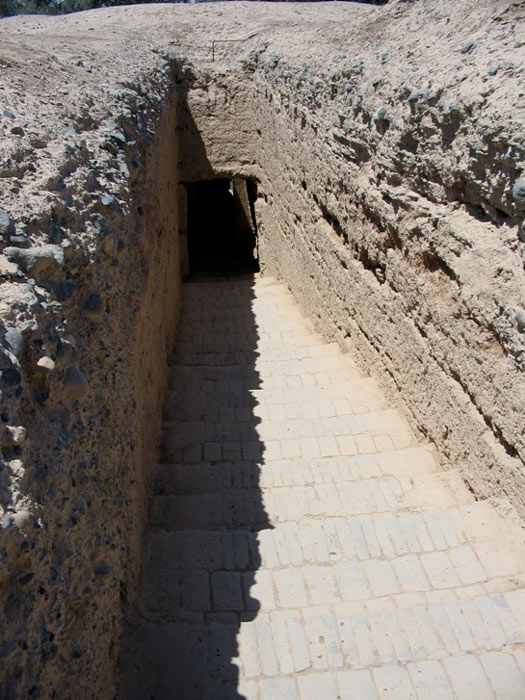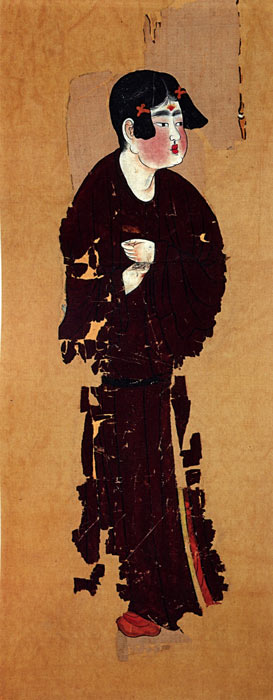
The Astana Cemetery and Perfectly Preserved Textiles of Gaochang
The Astana Cemetery is an ancient cemetery located near Turpan, in the autonomous region of Xinjiang, northwestern China. The cemetery was used during the 1st millennium AD by the inhabitants of Gaochang, an ancient oasis city on the northern edge of the Taklamakan Desert. The Astana Cemetery contains about 1000 tombs, of which about half have been excavated. The archaeological materials obtained from these excavations include mummified human remains, as well as artifacts that traveled along the Silk Road. These materials provide a glimpse into the life and death of the ancient inhabitants of Gaochang.

The ruins of the ancient Silk Road city of Gaochang, which is close to the Astana Cemetery, southeast of Turpan, China. (Colegota / CC BY-SA 2.5 ES)
The Astana Cemetery of Ancient Silk Road Gaochang
The Astana Cemetery lies about 40 kilometers (24.9 miles) to the southeast of Turpan, and 6 kilometers (4 miles) to the north of the ruins of Gaochang. The cemetery covers an area of 10 square kilometers (3.9 square miles), and contains up to 1000 tombs, which are distributed irregularly across the area. The Astana Cemetery was a public cemetery, containing the tombs of both aristocrats and commoners.
The Astana Cemetery was in use for several centuries, between the 3rd and 8th centuries AD. The dating of the cemetery’s use is based on the funerary tablets or bricks that were usually buried with the deceased. On these tablets were inscribed the name and biographical details of the deceased. The earliest of these tablets date to 273 AD, the period of the Western Jin dynasty, and the latest to 778 AD, the period of the Tang dynasty.
- The Colorful Folklore Behind the Flaming Mountains of Turpan
- Mysterious Stone Circles of Turpan Basin May be Bronze Age Sacrificial Sites to Solar Deity
These funerary tablets were not the only grave goods buried with the dead. Some of these objects, such as clay figurines and painted pottery, can survive in various climatic conditions, and have been frequently found by archaeologists in other burial contexts around the world. Unlike many other sites, however, the Astana Cemetery is situated in an area with dry climatic conditions, which has contributed towards the preservation of organic materials.

A weiqi player immortalized on a silk textile found in one of the Astana Cemetery graves, which because they were extremely dry allowed incredible textiles like these to survive time. (Public domain)
Textiles are one of the types of organic materials preserved by the dry climate of the Astana Cemetery. These were often embroidered and/or painted and are amongst the most impressive artifacts from the cemetery. An example of such an artifact is a piece of silk with the painting of Fuxi and Nuwa. These two figures are important cultural heroes in Chinese mythology, as they are believed to be the ancestors of the Chinese people.
- Archaeologists in China unearth 2,400-year-old Polo Sticks and Balls
- Archaeologists Are Surprised to Find a 2,500-Year-Old Cannabis Burial Shroud Found in China

A view of part of the Astana cemetery, 2007. (Public Domain)
Apart from textiles, the area’s dry climate also preserved paper artifacts. A total of 2000 documents have been unearthed at the Astana Cemetery. These cover a wide range of topics, including legal matters, public affairs, and military developments in Gaochang. Through these documents, scholars were able to gain an insight into many aspects of daily life in the ancient city.

Stairs leading to an underground tomb in the Astana Cemetery. (Otebig / Public domain)
Most of the Astana Cemetery Tombs Are Underground
As for the tombs in the Astana Cemetery, most of them have an underground passageway leading to the burial chamber, which is accessed via a rock-cut entrance. In some cases, the chamber is preceded by an antechamber containing stone statues of guardian beasts. The bodies, since husbands and wives are usually buried together, were placed at the back of the burial chamber.
The deceased were placed on an earthen or wooden bed, with a carved pillow under their heads, as though they were sleeping. They were dressed in silk, linen, or cotton, had a piece of cloth covering their faces, and a piece of wood clasped between their hands. Some of the bodies were found to have a Persian coin in their mouths. Apart from that, the bodies were naturally mummified due to the dry climate, allowing researchers to obtain information about the diet, health, and living conditions of those buried in the cemetery.

Portrait of a servant, mid-8th century, color on silk, Tang Dynasty, from the Astana graves. (Public domain)
Chinese Excavations at the Astana Cemetery Began in 1959
The Astana Cemetery was first excavated during the early 20th century. At that time, it was not Chinese archaeologists, but those from foreign imperial powers who conducted the excavations. These include Aurel Stein, Albert von Le Coq, and Sergey Oldenburg. In accordance with the spirit of the times, these archaeologists took many of the artifacts from the Astana Cemetery and shipped them back to museums in their home countries.
It was only from 1959 onwards that Chinese archaeologists began excavating the Astana Cemetery, along with the ruins of Gaochang. Over 10000 artifacts have been recovered during the excavations, most of which are now housed in the Xinjiang Museum in Urumqi.
- No Smoke Without Fire: The Existence of Xia Dynasty and the Great Flood Legend
- The Tang Dynasty: The Arts Flourished, Family Ties Broke, and a Concubine Became Empress
Today, the Astana Cemetery is a tourist attraction. The site is located not far from two other tourist attractions, the ancient ruins of Gaochang and the Bezeklik Thousand Buddha Grottoes. Therefore, visitors to the Turpan area may make a trip to all three sites.
Although about 500 tombs have been excavated, only three of them are open to the public. One of these tombs houses a pair of mummies, encased in glass, whilst the other two treat visitors to beautiful murals that decorate the walls of their burial chambers.
Top image: A stunningly made and preserved silk textile, one of many, found at the Astana Cemetery in far northwestern China. Source: Public domain
By Wu Mingren
References
Advantour, 2022. The Astana cemetery in the vicinity of Turfan. Available at: https://www.advantour.com/china/turpan/astana-cemetery.htm
Chong, D., 2019. Gaochang tombs unearth tales of ancient common civilization. Available at: https://www.shine.cn/feature/art-culture/1912208361/
en.chinaculture.org, 2008. Graveyard at Astana. Available at: http://en.chinaculture.org/library/2008-01/15/content_39479.htm
The British Museum, 2022. Astana. Available at: https://www.britishmuseum.org/collection/term/x21492
www.asiaculturaltravel.co.uk, 2022. Astana Cemetery. Available at: https://www.asiaculturaltravel.co.uk/astana-cemetery/















